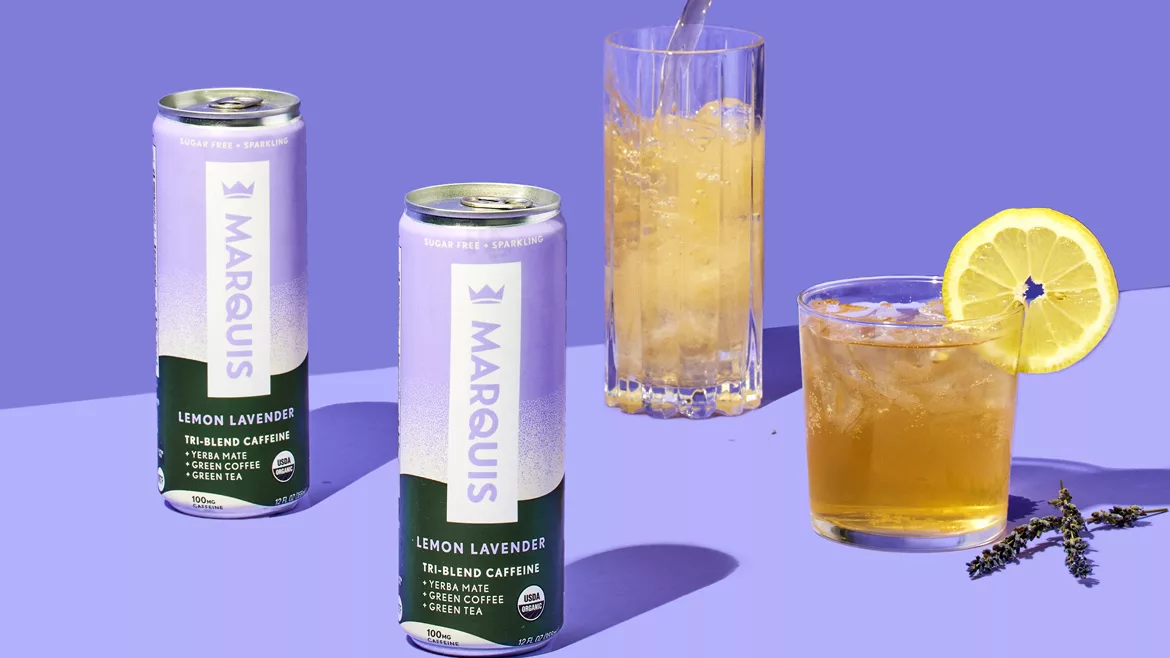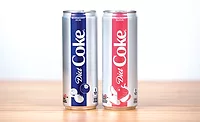Category Focus
Energy drink consumer’s loyalty keeps market thriving
Health consciousness, fitness influencing new age energy solutions

Image courtesy of Marquis
Sea monster buddies Alberto and Luca, who become human when dry on land, dream of owning a Vespa to tour the world in the Pixar film “Luca.” The duo team up with Giulia, a young girl from the coastal town Portorosso, to win the Portorosso Cup, a triathlon featuring swimming, pasta-eating and bike riding where the grand-prize is a Vespa. After a slew of obstacles that derail Luca and Alberto’s friendship and the competition, the duo eventually are able to buy a luxury scooter, only for Alberto to sell the vehicle so that Luca can attend a school in Genoa with Giulia. The loyalty of Alberto and Luca exemplifies a friendship built to last.
In Mintel’s 2023 report “Energy Drinks – US,” the Chicago-based market research firm highlights how loyalty extends beyond friendships as loyalty from energy drink consumers have helped this market thrive.
“Energy drinks remain a growing segment of the wider beverage industry, its growth attributed to core category loyalists as well as category newcomers attracted by [better-for-you] (BFY) energy drinks,” said Caleb Bryant, associate director of food and drinks reports at Mintel, in the report. “The energizing beverage landscape is rife with competitors, but energy drink brands can remain relevant by addressing consumers’ interest in health while also responding to consumers’ shifting energy needs.”
Although strongly supported by its loyalist consumers, analysts note that new comers to the category are helping with the continued strong performance.
“This combination of category loyalists and category newcomers will drive the market’s growth,” Mintel’s report states. “The market benefits from favorable conditions such as low unemployment and demographic shifts … indicating opportunities for energy drink brands to develop products for specific audiences such as older millennials and older Gen Alpha consumers.”
Sally Lyons Wyatt, executive vice president and practice leader of client insights at Chicago-based Circana, notes that consumer interest in the energy category has not waned, especially when compared with other functional beverages.
“Overall, the energy drinks category continues to have positive growth across dollars, units and volume showing consumers interest has not waned,” she says. “They have been outperforming other functional beverage categories as well.
“All segments within the category are growing in sales with the exception of energy shots, which has suffered declines,” Lyons Wyatt continues. “Energy drink mixes are demonstrating strength and growth across the metrics due to affordable price, convenience and flavors. These products are also fan favorites for Gen Alpha.”
Arielle Rose, senior analyst at IBISWorld, New York, also notes energy drinks positive performance when compared with other functional counterparts.
“Over the past year, the energy drinks and energy shots market has remained strong compared with other functional beverage categories that have sustained varied levels of demand,” she says. “The steady market for energy drinks and energy shots is mainly driven by factors like strengthening consumer focus on fitness, busy lifestyles and the boost of eCommerce platforms. In particular, as more people return back to the office post-COVID-19, more have been seeking beverages that provide them with a boost of energy.”
Yet, Rose notes that as consumers’ focus on health and functionality has risen, various functional beverage categories are gaining traction.
“Therefore, energy drinks and shots, while still popular, have faced strengthening competition from these emerging functional beverage categories,” she explains. “Also, negative publicity surrounding caffeine relating to safety concerns and poor ingredient content have given energy drinks and shots somewhat of a bad reputation. Brands are responding to this trend by reformulating their products with natural ingredients, reduced sugar and added functional benefits to cater to consumers’ evolving preferences.”
Healthy formulation goals
With the increased competition from functional beverages, research shows that performance beverages now are blurring the lines.
“Traditional energy drinks such as Red Bull and Monster dominate the energy drink market, yet segments such as fitness energy drinks and gamer energy drinks have successfully carved niches within the highly competitive energy drink market by catering to the health needs, energy needs, and interests of specific consumer groups,” Mintel’s report states. “For example, Celsius’ focus on healthy energy and aspirational fitness lifestyle marketing has made it one of the fastest-growing energy drink brands and has become popular among younger female consumers.”
Earlier this year, CELSIUS Energy, an entity of Boca Raton, Fla.-based Celsius Holdings Inc., expanded its Vibe product line with the limited-edition release of Oasis Vibe Sparkling Prickly Pear Lime, which features an exotic and delicately sweet flavor with a crisp and zesty clean citrus finish, the company says. This release follows the brand’s introduction of Sparkling Green Apple Cherry to its Essential Energy line.
Los Angeles-based Marquis also is appealing to the healthy-focused energy market with its lightly caffeinated beverages. Earlier this year, the brand released its first botanical-inspired flavor: Lemon Lavender. The new release combines lavender and citrus-forward lemon to create a balanced lift at a carefully calibrated 100 mg of caffeine in each 12-ounce can, with no sugar, calories or net carbs, the company says.
Consumer research shows that although consumers turn to energy drinks for the energy aspect, additional attributes also are sought from these beverages.
“In Circana’s 2023 Snacking Survey, 53% of consumers stated that energy drinks provide energy/fuel,” Circana’s Lyons Wyatt says. “In addition, 35% of consumers stated that energy drinks helped support their mental wellbeing, while 31% of consumers stated they help support immunity.
“Energy drinks that contain certain ingredients, such as L-citrulline, have been stated to not only help give you a more effective workout (accelerating metabolism and burn body fat), but also reduce high blood pressure, etc.,” she continues. “There are side effects as well to some ingredients, so experts are encouraging parents to look at the ingredients and monitor intake of younger consumers.”
IBISWorld’s Rose also notes how health consciousness has impacted the energy category.
“As consumers have become more health-conscious and wary of consuming large doses of caffeine and sugary beverages, the bubbles have begun to fizzle out,” she says. “This negative perception is expected to persist over the five years to 2028, which will likely slow the consumption of more traditional energy drinks goods, while even more consumers will look to consume ones with all-natural ingredients.
“That’s why manufacturers will introduce a larger variety of all-natural, non-GMO, preservative-free and organic energy drinks, appealing to consumers wary of the potential negative health consequences associated with artificial ingredients,” Rose continues. “More energy drink producers will continue to market brands to specific consumer groups and introduce new products, driving up the general population’s acceptance of energy drinks.”
Yet, fitness and health-focus are not the only avenues that energy drink manufacturers are taking to address consumer need states.
“Gamer energy drinks, while currently a small segment of the total market, are poised for strong growth considering gaming’s ubiquity among young consumers; 94% of teens aged 10-17 play video games, and playing video games is the top after-school leisure activity among males aged 10-17,” Mintel’s report states, citing data from its 2022 report “Teen & Team Gaming – US.”
|
|
DOLLAR SALES | % CHANGE vs PRIOR YEAR | MARKET SHARE | % CHANGE vs PRIOR YEAR | |
| 1 | Red Bull | $7,417,986,598 | 8.7 | 39.4 | -1.8 |
| 2 | Monster | $5,584,275,311 | 11.8 | 29.6 | -0.5 |
| 3 | Celsius | $1,192,808,213 | 135.4 | 6.3 | 3.3 |
| 4 | Bang | $731,035,677 | -41.6 | 3.9 | -3.7 |
| 5 | Rockstar | $719,660,599 | 2.7 | 3.8 | -0.4 |
| 6 | Reign | $498,835,648 | 16 | 2.7 | 0.1 |
| 7 | Nos | $467,854,391 | 14 | 2.5 | 0 |
| 8 | Ghost | $446,731,288 | 355.7 | 2.4 | 1.8 |
| 9 | C4 | $436,584,210 | 83.8 | 2.3 | 0.9 |
| 10 | Alani | $384,783,325 | 56.8 | 2 | 0.6 |
|
|
Total Sales* | $18,851,998,089 | 13.6 | 100 | --- |
*Includes brands not listed
Source: Circana, Chicago. Total U.S. supermarkets, drug stores, gas and convenience stores, mass merchandisers, military commissaries, and select club and dollar retail chains for the 52 weeks ending June 18.
Earlier this year, New York-based G FUEL, in partnership with HoYoverse, announced its new Traveler’s Ale flavor inspired by the wildly popular open-world adventure RPG Genshin Impact in Collector’s Boxes and Tubs at GFUEL.com while supplies last.
Genshin Impact is an open-world adventure RPG that takes place in Teyvat, a fantasy world where the seven elements flow and converge. The player takes on the role of the mysterious Traveler, who sets off on a journey in search of their lost sibling and unveils the mysterious secrets of Teyvat along the way, it says.
Featuring a Cactus Lime flavor, G FUEL Traveler’s Ale Collector’s Box comes with a 40-serving tub and new fully wrapped 24-ounce Steel Shaker Cup.
Flavor boost
Although taste and flavor are important to all beverage categories, analysts highlight the novel approach that energy drink manufacturers are willing to take to engage with consumers.
“Consumers seek out fun flavor combinations that are either favs from another category extending into energy shots (like co-licensed confection brand flavors) or whimsical flavors like Blue Blush, Peach Vibe, etc., that bring excitement and are a hit with consumers,” Circana’s Lyons Wyatt says.
Monster Energy, a brand of Monster Beverage Corp., expanded its Ultra line with the spring release of Strawberry Dreams, a zero sugar sweet and slightly tart energy drink.
“Our goal with Monster Ultra Strawberry Dreams was to create a beverage that feels like a wave of hypnotic flavor hitting you all at once,” said Dan McHugh of Monster Energy in a statement at the time of the release. “Drinking Monster Ultra Strawberry Dreams is a stimulating experience of all the senses, the beast within will be unleashed when you feel the good vibes touch your soul.”
Energy shot manufacturers also are stimulating consumer interest with flavor innovations. 5-hour Energy, a brand of Living Essentials, Farmington Hills, Mich., released Tidal Twist Extra Strength 5-hour ENERGY exclusively at participating 7-Eleven and Speedway stores.
“The new Tidal Twist flavor will take 5-hour ENERGY fans on a wild ride,” said Jeff Sigouin, president and CEO of 5-hour ENERGY products, in a statement. “We’re thrilled to partner with 7-Eleven to offer this limited-edition flavor exclusively to their customers. Fans of 5-hour ENERGY will find Tidal Twist flavor the perfect item to fuel their cross-country journeys or boost their favorite summer activity.”
IBISWorld’s Rose notes that energy drink manufacturers aren’t afraid to experiment with flavor combinations, but also are turning to natural solutions to help address sugar content.
“Ever-changing consumer preferences have led energy drink and energy shot producers to experiment with different flavors,” she says. “Examples of these flavors include tropical fruits like coconut-lime and mango-pineapple, mixed berries and citrus blends like lemon-lime, as well as spiced flavors like cayenne and turmeric.
“As demand for healthier options swells, energy drink flavors that use natural sweeteners like stevia or sugar alternatives are also becoming more prevalent in the market,” Rose continues. “Over the coming years, energy drink and shot producers will continue to evolve and introduce new and innovative flavor combinations, offering consumers a wider range of choices. These unique flavors appeal to the taste buds and seek to pique additional consumer interest.”
Looking for a reprint of this article?
From high-res PDFs to custom plaques, order your copy today!






